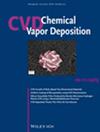丙烯酸己酯单体作为光引发CVD引发剂的潜力
引用次数: 11
摘要
研究了丙烯酸己酯在254 nm紫外辐射下的自聚合反应,探讨了丙烯酸己酯作为光引发CVD引发剂的潜力。在硅衬底上沉积聚丙烯酸己酯薄膜的速率很高,接近1.7 μ m min - 1,阶段温度为12.1°C,并且观察到该过程是吸附控制的。本文章由计算机程序翻译,如有差异,请以英文原文为准。
Potential of Hexyl Acrylate Monomer as an Initiator in Photo-initiated CVD†
The potential of hexyl acrylate as an initiator in photo-initiated (pi) CVD is explored by demonstrating its auto-polymerization under ultraviolet (UV) radiation of wavelength 254 nm. Deposition of poly(hexyl acrylate) films on silicon substrates proceeds at high rates, approaching 1.7 µm min−1, at a stage temperature of 12.1°C, and the process is observed to be adsorption controlled.
求助全文
通过发布文献求助,成功后即可免费获取论文全文。
去求助
来源期刊

Chemical Vapor Deposition
工程技术-材料科学:膜
自引率
0.00%
发文量
0
审稿时长
>12 weeks
期刊介绍:
Chemical Vapor Deposition (CVD) publishes Reviews, Short Communications, and Full Papers on all aspects of chemical vapor deposition and related technologies, along with other articles presenting opinion, news, conference information, and book reviews. All papers are peer-reviewed. The journal provides a unified forum for chemists, physicists, and engineers whose publications on chemical vapor deposition have in the past been spread over journals covering inorganic chemistry, materials chemistry, organometallics, applied physics and semiconductor technology, thin films, and ceramic processing.
 求助内容:
求助内容: 应助结果提醒方式:
应助结果提醒方式:


